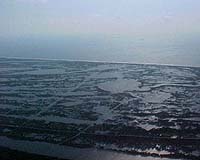| . |  |
. |
Grand Isle, Louisiana (AFP) May 22, 2010 A popular tourist beach in Louisiana remained closed due to oil contamination Saturday as BP officials denied botching the month-long clean-up and deliberately hiding the true extent of the spill. As Grand Isle, Louisiana, closed its seven-mile beach to clean up an orange-liquidy slick washing ashore, the British energy giant once again postponed an operation aimed at permanently stopping the leak. The "top-kill" operation to inject heavy drilling fluids into the ruptured well, a month after the sinking of the Deepwater Horizon rig, and then seal it permanently with cement, will now not take place until Tuesday at the earliest instead of at the weekend. Just how much oil is gushing daily from the rig's wreckage has been a contentious issue, with BP initially putting the figure at 5,000 barrels -- or 210,000 gallons. "That was not just BP's estimate. That was the estimate of the in-flight command, including NOAA and the Coast Guard. That's the best estimate we have," BP's chief operating officer Doug Suttles told ABC television Friday. But in further confusing comments, BP also radically slashed by more than half its figures for how much of the oil it is siphoning up daily from the ruptured well via a mile-long (1,600 meter) insertion tube. BP spokesman John Curry told AFP Friday that it now estimated some 92,400 gallons of oil had been diverted from the well in the 24 hours before midnight on Thursday. That would mean BP is sucking up only 2,200 barrels daily from the pipe, not the 5,000 barrels it had estimated on Thursday. Coast Guard commandant Thad Allen later told reporters that the flow was variable, fluctuating from a low rate of 2,000 barrels a day to a high of 5,000 barrels. Live webcam pictures showed more oil continuing to spew into the Gulf from the ruptured well -- as visitors flocked to BP's site to watch the video. Even at the lowest estimates, more than six million gallons of crude have flowed into the water since the disaster. And independent experts have warned the flow could be at least 10 times higher than the current estimates. Grand Isle shut down its beach as volunteers armed with spades sought to scoop up the oil into plastic bags. "This is only the beginning. It happened 30 days ago and it just came yesterday. Yesterday, it was the very first, it was very little, and now it's all over," said angry resident, 69-year-old Lana Downing. Charter boat captain Larry Averitt said impatience was also growing further along the coast in Venice, Louisiana. "In the beginning, everybody was trying to be patient. People are starting to get exasperated. It's definitely affecting our ability to make a livelihood and pay our bills," he told AFP. "Nothing BP has tried so far has worked." Suttles sought to quell the growing anger among the US administration, telling ABC television that BP had already spent 700 million dollars on the clean-up. "We've mounted the largest response ever done in the world. We put 20,000 people at this. "I understand the anger. But I can tell you, I don't know of anything, absolutely anything we could be doing that we're not doing," he said. But he also revised the timetable for when BP would attempt its latest bid to stop the leak, the "top kill" operation. "Our current forecast for when this operation will take place is sometime in the early part of next week. The best estimate is Tuesday," Suttles told reporters. He added the operation was very complex and was being carried out by robotic submarines positioning the equipment on the seabed a mile down. BP PLC, owner of the damaged well, predicts it will take 70 to 90 days - perhaps into August - to stab through more than three miles (five kilometers) of seawater and earth and puncture the vertical pipe that is channeling a torrent of oil and gas to the surface of the Gulf near the Louisiana coast. US officials have insisted that BP provide a wealth of technical information to the EPA and the National Oceanic and Atmospheric Administration (NOAA) to help them fight the slick. Democratic congressman Ed Markey voiced the frustrations of many, saying: "We're beginning to understand that we cannot trust BP. People do not trust the experts any longer. BP has lost all credibility." Meanwhile, senators from four oil-producing states Friday wrote to Interior Secretary Ken Salazar asking that the government exempt shallow-water drilling from a moratorium on new offshore oil drilling.
Share This Article With Planet Earth
Related Links Our Polluted World and Cleaning It Up
 Louisiana marshes hit by Gulf oil slick
Louisiana marshes hit by Gulf oil slickVenice, Louisiana (AFP) May 20, 2010 Crude oozed Thursday into US wetlands, prompting furious Louisiana officials to accuse BP of destroying fragile marshes beyond repair and leaving coastal fishing communities in ruin. With some of the worst fears of environmental disaster being realized in the marshlands of the Mississippi Delta, BP was also forced to concede it had underestimated the amount of oil leaking into the Gulf of Me ... read more |
|
| The content herein, unless otherwise known to be public domain, are Copyright 1995-2010 - SpaceDaily. AFP and UPI Wire Stories are copyright Agence France-Presse and United Press International. ESA Portal Reports are copyright European Space Agency. All NASA sourced material is public domain. Additional copyrights may apply in whole or part to other bona fide parties. Advertising does not imply endorsement,agreement or approval of any opinions, statements or information provided by SpaceDaily on any Web page published or hosted by SpaceDaily. Privacy Statement |